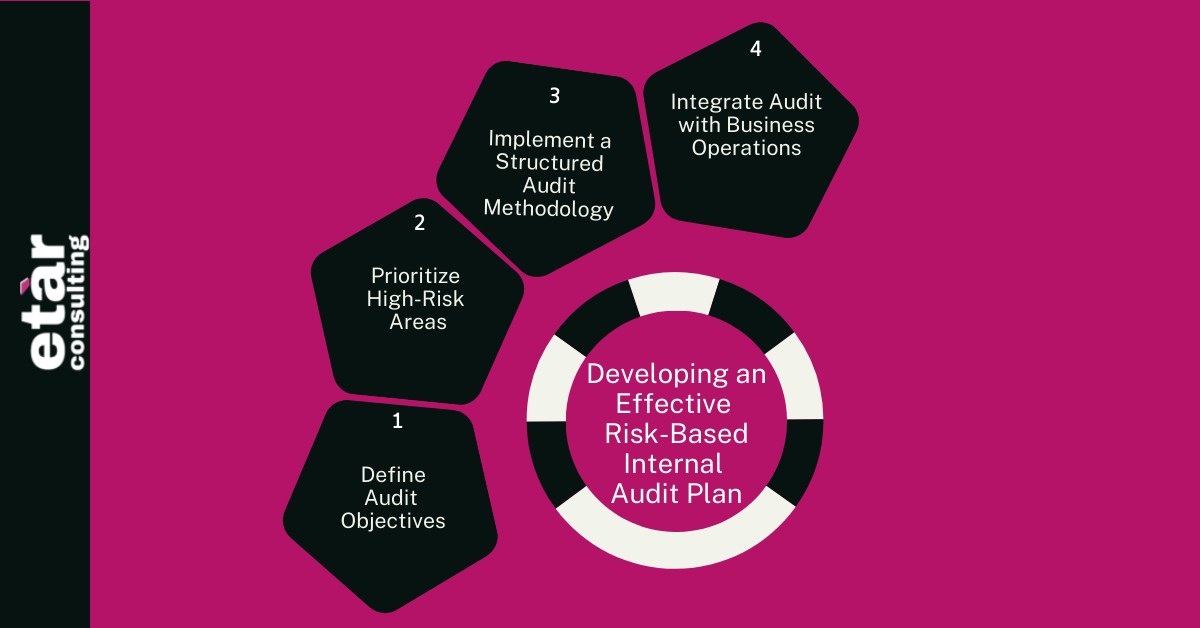
Introduction to Risk-Based Internal Auditing
As businesses grow, so do their risks. A traditional internal audit approach may not always identify the most critical threats to an organization. That’s where risk-based internal auditing (RBIA) comes in. RBIA focuses on identifying and assessing risks that could impact business objectives, ensuring that internal audits contribute directly to strategic success.
For businesses looking to enhance their audit process, ETAR Consulting offers specialized services in internal audit, risk management, and compliance. With expertise in risk-based auditing, ETAR Consulting helps companies navigate complex challenges and strengthen their internal controls.
Key Principles of Risk-Based Internal Auditing
1. Identifying and Assessing Business Risks
The first step in a risk-based audit is identifying potential risks. These can include financial, operational, regulatory, and reputational risks. Organizations need a structured risk assessment process to categorize risks based on their likelihood and impact.
2. Aligning Audit Plans with Business Goals
Unlike traditional audits that follow a fixed checklist, RBIA aligns audit priorities with business objectives. High-risk areas that could significantly affect performance should receive more attention than lower-risk ones.
3. Strengthening Internal Controls
Strong internal controls are the backbone of a risk-based audit approach. Organizations must ensure their control measures effectively mitigate risks, helping to prevent fraud, financial mismanagement, and regulatory non-compliance.
Developing an Effective Risk-Based Internal Audit Plan

Creating a well-structured audit plan is essential for successful RBIA implementation. Here’s how businesses can develop one:
1. Define Audit Objectives
Clearly outline the audit goals and ensure they align with key business risks and priorities.
2. Prioritize High-Risk Areas
Focus on areas with the highest potential for financial loss or compliance violations. This ensures that resources are used effectively.
3. Implement a Structured Audit Methodology
A risk-based internal audit plan should include clear procedures for conducting audits, reporting findings, and following up on corrective actions.
4. Integrate Audit with Business Operations
A risk-based approach isn’t just about compliance—it should also contribute to operational improvements and strategic decision-making.
Risk Identification and Assessment Techniques
A thorough risk assessment is critical for effective auditing. Here are some proven techniques:
1. Data Analytics for Risk Detection
Advanced data analysis tools help businesses identify unusual patterns and discrepancies, making audits more accurate and efficient.
2. Industry-Specific Risk Considerations
Every industry has unique risks. For example, financial firms face compliance challenges, while manufacturing companies deal with operational and supply chain risks.
3. Common Business Risks
Some of the most common risks businesses encounter include:
- Financial risks (fraud, misstatements, cash flow problems)
- Operational risks (process inefficiencies, lack of automation)
- Regulatory risks (non-compliance with laws and industry standards)
Best Practices for Conducting Risk-Based Audits
1. Improving Audit Efficiency and Accuracy
Companies should leverage audit risk management tools to automate processes, reducing errors and enhancing reliability.
2. Leveraging Technology for Smarter Auditing
Using audit management software can streamline documentation, risk assessment, and reporting, making audits more efficient.
3. Ensuring Compliance with International Standards
Businesses should follow recognized auditing standards to maintain credibility and compliance. These include:
- International Standards for the Professional Practice of Internal Auditing (IPPF)
- ISO 31000 (Risk Management)
Enhancing Business Growth Through Risk-Based Auditing
When conducted effectively, a risk-based audit doesn’t just identify problems—it also creates opportunities for business improvement.
1. Strengthening Financial and Operational Controls
Well-implemented internal audit strategies improve financial accuracy and prevent fraud, leading to more sustainable growth.
2. Minimizing Fraud and Compliance Risks
A proactive approach ensures that businesses stay compliant with evolving regulations and prevent costly penalties.
3. Using Audit Insights to Drive Strategic Decisions
Internal audits provide valuable data that can inform business decisions, helping companies mitigate risks and seize new opportunities.
Common Challenges in Risk-Based Internal Auditing
Despite its benefits, implementing RBIA comes with challenges:
1. Overcoming Resistance to Change
Some organizations resist shifting to risk-based auditing due to a lack of awareness or concerns about disrupting existing processes.
2. Balancing Risk and Business Innovation
Businesses must mitigate risks without stifling innovation, ensuring that risk management supports, rather than hinders, growth.
3. Ensuring Continuous Improvement
Auditing should not be a one-time process. Regular risk assessments and audits keep businesses agile and prepared for emerging threats.
How ETAR Consulting Supports Risk-Based Auditing
As a leader in internal audit and risk management, ETAR Consulting provides expert guidance to businesses looking to strengthen their auditing framework.
ETAR Consulting’s Key Services Include:
Internal audit training to improve audit effectiveness
Risk assessment consulting to identify and mitigate risks
Regulatory compliance solutions to ensure adherence to industry standards
With ETAR Consulting’s expertise, businesses can streamline their internal audit processes, enhance compliance, and drive long-term success.
Explore more Internal Audit Tips for Business Growth
| Internal Audit | Tips |
| – Importance of internal audit training – Best practices for training auditors – How to develop audit skills effectively | |
| – Understanding risk-based audit approach – Developing a risk-based audit plan – Improving risk management strategies | |
| – Essential technical and communication skills – Competencies of an effective auditor – How to improve audit efficiency | |
| – Enhancing business operations through audits – Key steps for a successful operational audit – Improving internal control efficiency | |
| – Importance of risk assessment in internal controls – Key risk assessment procedures – How to strengthen risk management frameworks |
Conclusion

As business risks continue to evolve, risk-based auditing will play a crucial role in ensuring financial stability, regulatory compliance, and operational efficiency. Implementing a well-structured risk-based internal audit plan helps organizations focus on high-risk areas, improve decision-making, and enhance overall business performance.
Companies must adopt a proactive, technology-driven approach to auditing while aligning their audit strategies with broader business objectives. By integrating a risk-based audit methodology, businesses can mitigate potential threats, optimize internal controls, and ensure long-term success.
By partnering with ETAR Consulting, businesses can stay ahead of risks and build a more secure, compliant, and growth-oriented future.
FAQs on Risk-Based Internal Auditing
1. What is the main objective of risk-based auditing?
RBIA focuses on identifying and managing risks that could impact business objectives, ensuring that audits are aligned with strategic goals.
2. How can businesses identify high-risk areas?
By conducting a risk assessment, analyzing financial and operational data, and monitoring industry trends, businesses can pinpoint high-risk areas.
3. What tools and technologies support risk-based audits?
Audit management software, data analytics tools, and risk assessment frameworks help enhance audit accuracy and efficiency.
4. How often should risk assessments be conducted?
Risk assessments should be performed annually or whenever significant changes occur in the business environment.
5. How does ETAR Consulting help businesses implement risk-based auditing?
ETAR Consulting provides customized risk assessment solutions, internal audit training, and regulatory compliance support, helping businesses build a strong and efficient audit framework.

